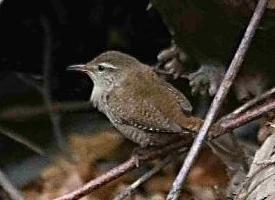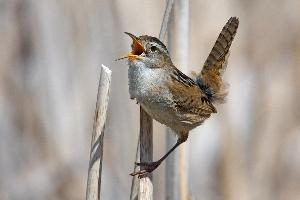
Greutăți și măsuri
| Lungime | de la 14 la 16 cm |
|---|
Starea de conservare
| Neînfricat |
Descrierea animalului
The Rock Wren (Salpinctes obsoletus) is a small, charismatic bird that belongs to the wren family, Troglodytidae. It is primarily found in the western parts of North America, from southern Canada through the United States to Central America. This species is particularly known for its remarkable adaptation to rocky environments, where it not only nests but also forages and performs its vivacious vocal displays.Physical Description:
Rock Wrens are small birds, measuring about 5.5 to 6.5 inches in length, with a wingspan that ranges from 7 to 9 inches. They have a relatively compact body, with a short neck and a long, slender, slightly curved beak which is well adapted for probing crevices in rocks for insects. Their plumage is predominantly grayish-brown, which provides excellent camouflage against the rocky landscapes they inhabit. The bird's underparts are paler, often showing a whitish or light buff color, and their tails are barred with black and have a distinctive white tip. One of the most striking features of the Rock Wren is its bright white eyebrows, which stand out against its grayish face.
Habitat and Distribution:
Rock Wrens have a strong preference for arid, rocky terrains. They are commonly found in canyons, rocky outcrops, and boulder fields, and they are adept at navigating this rugged landscape. Their range extends from the southern parts of Canada, throughout the western United States, and down into Mexico and Central America. They are mostly resident birds, although populations in the northernmost parts of their range may migrate short distances southward during the winter months.
Behavior and Diet:
The Rock Wren is an industrious forager, primarily feeding on insects and spiders. It hunts by hopping and flitting from rock to rock, using its sharp beak to extract prey from crevices. Its diet includes a wide variety of arthropods, which it adeptly captures with its agile movements.
One of the most fascinating aspects of the Rock Wren's behavior is its nesting habits. The species is known to build its nest in the crevices of rocky cliffs or among piled boulders. The nest itself is a remarkable construction, often lined with feathers and plant material, and uniquely, the entrance is typically paved with small stones. This behavior is thought to play a role in deterring predators or may serve as a display to attract mates.
Vocalizations:
Rock Wrens are also notable for their vocal abilities. They have a rich repertoire of songs and calls, which include trills, buzzes, and clear whistles. Males are particularly vocal during the breeding season, using their songs both to attract mates and to defend their territory. The song of the Rock Wren is a delightful melody, often described as complex and variable, adding a layer of acoustic beauty to their rugged habitats.
Conservation Status:
Currently, the Rock Wren is listed as Least Concern by the International Union for Conservation of Nature (IUCN). The species is relatively widespread and common within its range. However, like many birds, it faces threats from habitat destruction and degradation. Conservation efforts aimed at preserving natural habitats are essential for ensuring the long-term survival of this and many other bird species.
In conclusion, the Rock Wren is a small yet fascinating bird, well adapted to life in the rocky landscapes of North America. Its unique nesting behaviors, adept foraging skills, and melodious vocalizations make it a captivating subject of study and observation for bird enthusiasts and researchers alike.
Animale similare
Fotografii noi cu animale
Top 10 animale
- Diana monkey (Cercopithecus diana)
- Dolphin gull (Leucophaeus scoresbii)
- Galápagos tortoise (Geochelone nigra complex)
- Moustached guenon (Cercopithecus cephus)
- Japanese spider crab (Macrocheira kaempferi)
- Colossal squid (Mesonychoteuthis hamiltoni)
- Fox tapeworm (Echinococcus multilocularis)
- Stone loach (Barbatula barbatula)
- Japanese macaque (Macaca fuscata)
- Barbary macaque (Macaca sylvanus)

